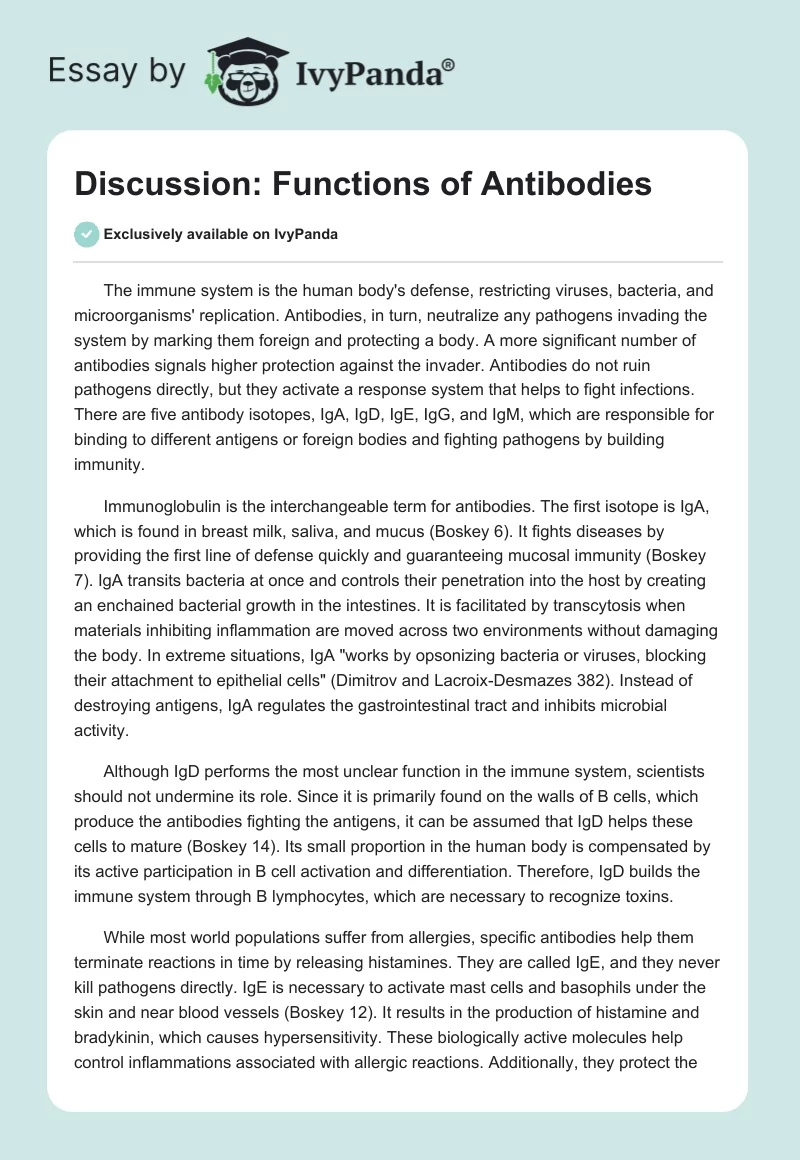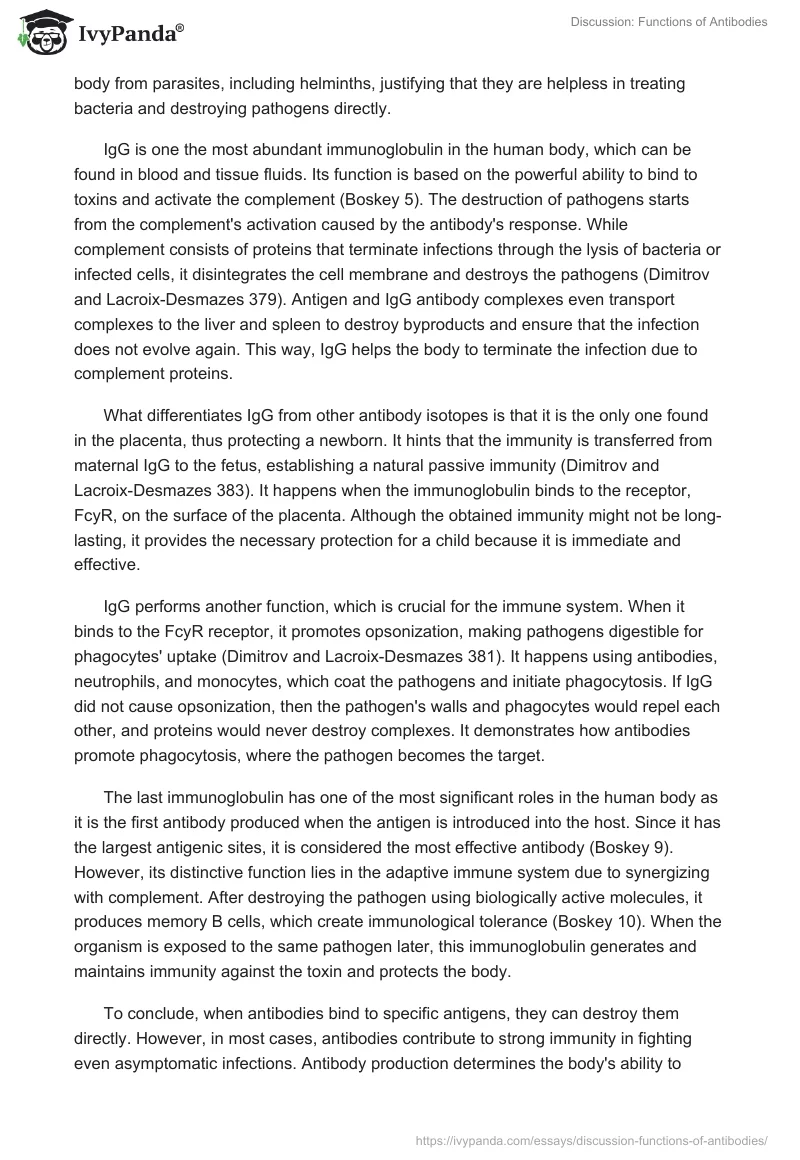The immune system is the human body’s defense, restricting viruses, bacteria, and microorganisms’ replication. Antibodies, in turn, neutralize any pathogens invading the system by marking them foreign and protecting a body. A more significant number of antibodies signals higher protection against the invader. Antibodies do not ruin pathogens directly, but they activate a response system that helps to fight infections. There are five antibody isotopes, IgA, IgD, IgE, IgG, and IgM, which are responsible for binding to different antigens or foreign bodies and fighting pathogens by building immunity.
Immunoglobulin is the interchangeable term for antibodies. The first isotope is IgA, which is found in breast milk, saliva, and mucus (Boskey 6). It fights diseases by providing the first line of defense quickly and guaranteeing mucosal immunity (Boskey 7). IgA transits bacteria at once and controls their penetration into the host by creating an enchained bacterial growth in the intestines. It is facilitated by transcytosis when materials inhibiting inflammation are moved across two environments without damaging the body. In extreme situations, IgA “works by opsonizing bacteria or viruses, blocking their attachment to epithelial cells” (Dimitrov and Lacroix-Desmazes 382). Instead of destroying antigens, IgA regulates the gastrointestinal tract and inhibits microbial activity.
Although IgD performs the most unclear function in the immune system, scientists should not undermine its role. Since it is primarily found on the walls of B cells, which produce the antibodies fighting the antigens, it can be assumed that IgD helps these cells to mature (Boskey 14). Its small proportion in the human body is compensated by its active participation in B cell activation and differentiation. Therefore, IgD builds the immune system through B lymphocytes, which are necessary to recognize toxins.
While most world populations suffer from allergies, specific antibodies help them terminate reactions in time by releasing histamines. They are called IgE, and they never kill pathogens directly. IgE is necessary to activate mast cells and basophils under the skin and near blood vessels (Boskey 12). It results in the production of histamine and bradykinin, which causes hypersensitivity. These biologically active molecules help control inflammations associated with allergic reactions. Additionally, they protect the body from parasites, including helminths, justifying that they are helpless in treating bacteria and destroying pathogens directly.
IgG is one the most abundant immunoglobulin in the human body, which can be found in blood and tissue fluids. Its function is based on the powerful ability to bind to toxins and activate the complement (Boskey 5). The destruction of pathogens starts from the complement’s activation caused by the antibody’s response. While complement consists of proteins that terminate infections through the lysis of bacteria or infected cells, it disintegrates the cell membrane and destroys the pathogens (Dimitrov and Lacroix-Desmazes 379). Antigen and IgG antibody complexes even transport complexes to the liver and spleen to destroy byproducts and ensure that the infection does not evolve again. This way, IgG helps the body to terminate the infection due to complement proteins.
What differentiates IgG from other antibody isotopes is that it is the only one found in the placenta, thus protecting a newborn. It hints that the immunity is transferred from maternal IgG to the fetus, establishing a natural passive immunity (Dimitrov and Lacroix-Desmazes 383). It happens when the immunoglobulin binds to the receptor, FcyR, on the surface of the placenta. Although the obtained immunity might not be long-lasting, it provides the necessary protection for a child because it is immediate and effective.
IgG performs another function, which is crucial for the immune system. When it binds to the FcyR receptor, it promotes opsonization, making pathogens digestible for phagocytes’ uptake (Dimitrov and Lacroix-Desmazes 381). It happens using antibodies, neutrophils, and monocytes, which coat the pathogens and initiate phagocytosis. If IgG did not cause opsonization, then the pathogen’s walls and phagocytes would repel each other, and proteins would never destroy complexes. It demonstrates how antibodies promote phagocytosis, where the pathogen becomes the target.
The last immunoglobulin has one of the most significant roles in the human body as it is the first antibody produced when the antigen is introduced into the host. Since it has the largest antigenic sites, it is considered the most effective antibody (Boskey 9). However, its distinctive function lies in the adaptive immune system due to synergizing with complement. After destroying the pathogen using biologically active molecules, it produces memory B cells, which create immunological tolerance (Boskey 10). When the organism is exposed to the same pathogen later, this immunoglobulin generates and maintains immunity against the toxin and protects the body.
To conclude, when antibodies bind to specific antigens, they can destroy them directly. However, in most cases, antibodies contribute to strong immunity in fighting even asymptomatic infections. Antibody production determines the body’s ability to withstand diseases. It happens because different isotopes of immunoglobulins perform various functions. While IgA forms the first-line defense against infection and IgE regulates allergic responses through histamines, IgD controls B cells. Most importantly, IgG performs opsonization, complement activation, and the creation of natural passive immunity. IgM helps create memory B cells and adaptive immunity to specific pathogens so that they do not disturb the body’s function again.
Works Cited
Boskey, Elizabeth. “What Are the 5 Types of Antibodies? “. Very Well Health. Web.
Dimitrov, Jordan D., and Lacroix-Desmazes, Sébastien. “Noncanonical Functions of Antibodies.” Trends in Immunology, vol. 41, no. 5, 2020, pp. 379-393.


